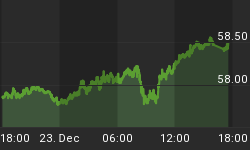- Many institutional equity managers must remain fully invested at all times in order to stay in-line with a growth mandate, meaning stock rotation is their primary risk management tool.
- If managers were positioning for economic and equity weakness, we would expect to see increasing demand for defensive consumer staples stocks, and decreasing demand for growth-oriented small caps.
- The demand for small caps has been outpacing the demand for consumer staples, which aligns with a "risk-on" market profile and leans bullish for the equity markets.
- With ongoing QE and still extremely low interest rates, monetary policy continues to push investors toward stocks rather than low-yielding fixed income instruments.
Low Inflation Gives Fed Some Breathing Room

In Mondays article, we outlined the expectation for Wednesdays Fed meeting, which centers around a change to their forward guidance. Tuesdays economic data supports an ongoing "low rate" pledge. From Reuters:
U.S. inflation was muted in February and housing starts fell for a third straight month, giving the Federal Reserve plenty of room to keep interest rates low even as it scales back the amount of money it is pumping into the economy. The data, which came as the Fed opened a two-day policy meeting, painted a picture of sluggish economic growth in the first quarter as unseasonably cold weather disrupted activity. A jump in building permits last month, however, also offered cautious optimism for an acceleration once the weather warms up.
Supply, Demand, And Economic Common Sense
If we were taking an investment quiz and the question was:
When expectations are for continued economic growth, would you rather own defensive consumer staples (XLP) or small caps (IWM)?
The easy answer is small caps. Therefore, if demand for consumer staples is lagging the demand for small caps, we can surmise the market expects the economy to avoid a recession and continue to expand.
2011 Example: Investors Were Fearful
Using the same economic logic, we would expect defensive consumer staples to be in greater demand than growth-oriented small caps when economic fear was ruling the day. That is exactly what occurred in 2011, with XLP outpacing IWM for several months before the S&P 500s waterfall decline in August 2011.

2014: Is Fear Or Confidence In Charge
As shown in the 2014 version of the same ratio, fear is taking a back seat to economic confidence with consumer staples lagging small caps.

Is tracking the ratio above a foolproof way to monitor risk? No, but it is helpful from a probability perspective and can be used in conjunction with other methods.
From Russia With Love
Sometimes it is difficult to discern what is spooking the markets during a bout of weakness. For example, last week you could have made rational arguments for Russia, tapering, or weak economic data. The reaction to the diminished threat of imminent military action in Ukraine tells us Russia was the primary concern last week. From Yahoo Finance:
In an address to the Russian parliament, Putin said Russia didnt want Ukraine to be divided further, and that he did not want to seize more of the country after approving plans to make Crimea part of Russia following a disputed referendum. "What had been going on in the Ukraine has been weighing on the minds of investors for a while, so it is a relief that we are apparently moving beyond this," said Joseph Tanious, global market strategist at J.P. Morgan Asset Management in New York.
Investment Implications - Bears Have Not Capitalized
Given the uncertainty in Ukraine and last weeks selloff in stocks, it would have been easy to enter this week with a bearish bias and with the felling that "we know what is going to happen next." Just as a new bear market did not start "as expected" in October 2011, the vulnerable set-ups from last week thus far have not morphed into a correction. This week is an example of why maximum flexibility is required to stay aligned with the financial markets. For the record, the S&P 500 (SPY) has tacked on 31 points this week. The S&P 500 has recaptured 1,848 and the Dow has bounced at a logical area of support (see chart below).

Our market model tracks observable evidence and recommends a prudent allocation between growth and conservative assets. As you might imagine, the evidence has improved this week. Consequently, we redeployed cash Monday and Tuesday into U.S. stocks (RSP). With the Fed waiting on deck, we still have a cash buffer in place should the bears assert themselves.















